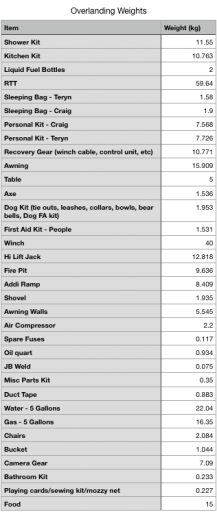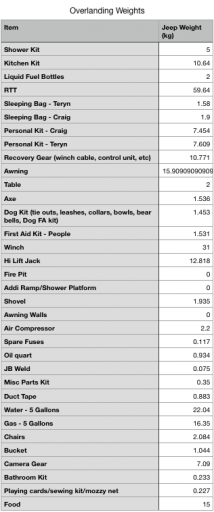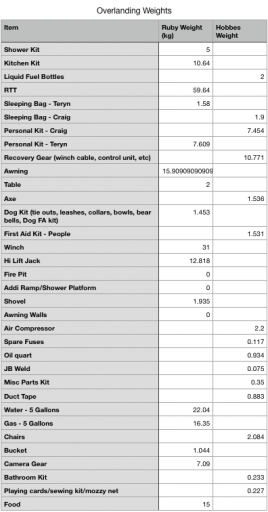Here is a post I made on Expo of our weighing process; hopefully it's useful to some. As I mentioned, after this process we replaced the Jeep with a mid-sized Truck. The point is, as Bill Burr says: "Getting fit is hard. It's a lot of work. You hear about people
trying to lose weight all the time, and it's a chore. Ever hear of someone
trying to get fat? No. It just happens. It's
effortless!".
_______________________
To continue this thread/idea a bit, my wife and I tore through all our gear and weighed everything. A couple of notes:
1) There are some items that 'live' in the jeep -- tools, spare parts, etc. mostly stay in there permanently, and are not broken out individually but included in the "unloaded jeep weight"
2) The JK, as previously mentioned, is a 2013 Rubicon, Smittybilt XRC front and rear bumpers, custom rear tire carrier/jerry can holder, Gobi stealth roof rack, HAM Radio, and water pump. The rest is stock. All of these items are permanently bolted on and are also accounted for in the 'unloaded jeep weight' figure.
3) Our trips are rarely weekends only -- we generally have to live off our vehicles for a month at a time, going into towns and cities as rarely as possible and only when we need food or gas, so that greatly informs some of our needs like a shower and such. We mostly eat dried foods and fresh fruit, and neither of us drink anymore so we have no need for a cooler or a fridge.
The short version:
Metric
Unloaded Jeep Weight: 2268 Kilograms
Equipment Weight: 286 Kilograms
People/Dogs: 210 Kilograms
Total Weight: 2764 Kilograms
GVWR: 2590 Kilograms
Total: 174.3 Kilograms over GVWR
Freedom Units
Unloaded Jeep Weight: 4989 lbs
Equipment Weight: 629.2 lbs
People/Dogs: 462 lbs
Total Weight: 6080.8
GVWR: 5700 lbs
Total: 383.46 lbs over GVWR
Here's a breakdown of what we weighed with our "everything we want to bring" list; some things are estimates but this will give others a fair idea of how much some of this stuff weighs; the below items, in total, are the 286kgs/629.2 lbs

Now, the real fun part was trying to decide what was "nice to have' versus "need to have". Here is where we got on our "Need to have" list; in this configuration we've stripped out a lot of the creature comforts. This puts us at 243 kgs/534.6 lbs of equipment, and importantly, even after shedding the 'nice to have' stuff, we are still 131.4kgs/289.08lbs over GVWR!

There are quite a few things we can go without -- maybe, like the hi-lift jack. But, it's one of those things where if you need it, you need it. Other areas we saved some weight are in things like the Shower Kit and Table -- for instance, our current shower kit is a propane RV water heaters stored in a pelican case. It' brilliant but we can save some weight using an onboard heat exchanger. The table is a very light aluminum one, but a tailgate table will work just as well for a few less pounds. We can also sub out our metal winch rope for a synthetic one. There are a few other example of areas we 'shaved' weight without removing items.
And now here's the final chart. This one more accurately reflects a 'real' trip for us, where my wife is in the JK with the dogs, and I'm on my triumph. We communicate all day via radio and sort of convoy around the place. We do this for two reasons. First, and primarily, I really love riding. Second, having an additional vehicle allows us to go to more remote places safely, as if there is a failure of one rig, we have another to go for help on. Here's the list of weights for that scenario; this means we've split the gear up between the bike (Hobbes) and the Jeep (Ruby), resulting in Hobbes hauling 32kg/70lbs and Ruby hauling 211kg/464.20lbs. In this scenario, Ruby loses an additional 90kgs since I'll be on the bike, but even then she is still 9.1 kgs over GVWR -- much closer, but still a problem technically. And, we eventually want to have kids which will add a good chunk of weight.

However, not all is lost -- some quick math shows that if we went with Aluminum bumpers instead of the Smittybilt ones, we'd save
74kg/162.8lbs! These numbers are based off advertised weights for both styles of bumper, and even if that is a bit inflated due to shipping material, a savings of 50kgs/110lbs seems very reasonable from this one change alone. This change would put us about 64kgs under GVWR.
Similar changes that could be made would be things like swapping the steel skid plates with Aluminum ones, netting another few pounds. However other changes -- like swapping the hardtop for a soft top (Saving about 75 lbs, from what I read) comes with a significant noise/comfort/security sacrifice. Other mods -- like swapping the hood for a fibreglass one, have their own set of problems since our dogs use the hood of the jeep to get into the tent.
Hopefully this experience we just had helps inform others when selecting an Overland rig, and highlights how easy it is to do "typical" mods and still completely blow past the GVWR without even really trying. We've got more work to do on sorting out our weight issue. Our goal is to land at 2500kgs/5500lbs, so we've got a long way to go!










